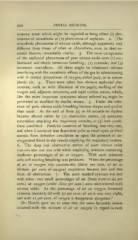Page 482 - My FlipBook
P. 482
480 DENTAL MEDICINE.
nomena arose which might be regarded as being either (i) phe-
nomena of anaesthesia or (2) phenomena of asphyxia. 2. The
anaesthetic phenomena of nitrous oxide, although apparently very
different from those of ether or chloroform, were in their es-
sential features remarkably similar. 3. The most conspicuous
of the asphyxia] phenomena of pure nitrous oxide were (i) em-
barrassed and deeply stertorous breathing; (2) cyanosis; and (3)
anoxemic convulsion. All these might be eliminated without
interfering with the anaesthetic effects of the gas by administering
with it certain proportions of oxygen, either pure, or as atmos-
pheric air. 4. There were other less obvious asphyxial phe-
nomena, such as wide dilatation of the pupils, swelling of the
tongue and adjacent structures, and rapid cardiac action, which,
like the more important symptoms above referred to, might be
prevented or modified by similar means. 5. Under the influ-
ence of pure nitrous oxide breathing became deeper and quicker
than usual. At the end of from 55 to 66 seconds its rhythm
became altered either by (i) obstructive stertor, (2) anoxemic
convulsion attacking the respiratory muscles, or both condi-
(3)
tions combined. Paralytic cessation of breathing was very rare,
and when it occurred was dependent quite as much upon cerebral
anemia from defective circulation as upon the presence of un-
oxygenated blood in the vessels supplying the respiratory centres.
6. The deep and obstructive stertor of pure nitrous oxide
narcosis was not met with when employing mixtures containing
moderate percentages of air or oxygen. With such mixtures
only soft snoring breathing was produced. When the percentage
of air or oxygen was considerable (thirty per cent, of air or
thirteen per cent, of oxygen) respiration became less and free
from all obstruction. 7. The most marked cyanosis was met
with when very small percentages of air (from three to six per
cent.) or oxygen (under three per cent.) were administered with
nitrous oxide. As the percentage of air or oxygen increased
cyanosis lessened, till with 30 per cent, of air it was very slight,
and with 11 per cent, of oxygen it disappeared altogether."
Dr. Hewitt goes on to state that the same favorable results
occurred with the mixture of air or oxygen in regard to such


